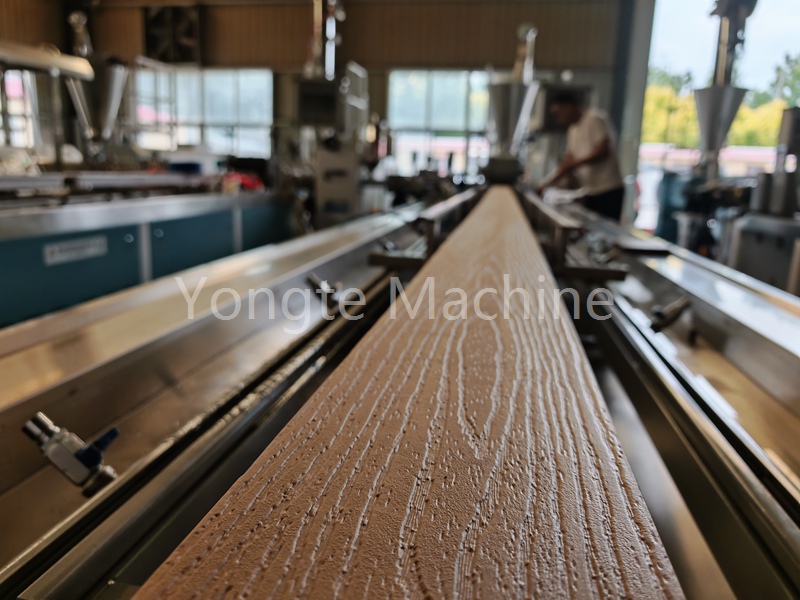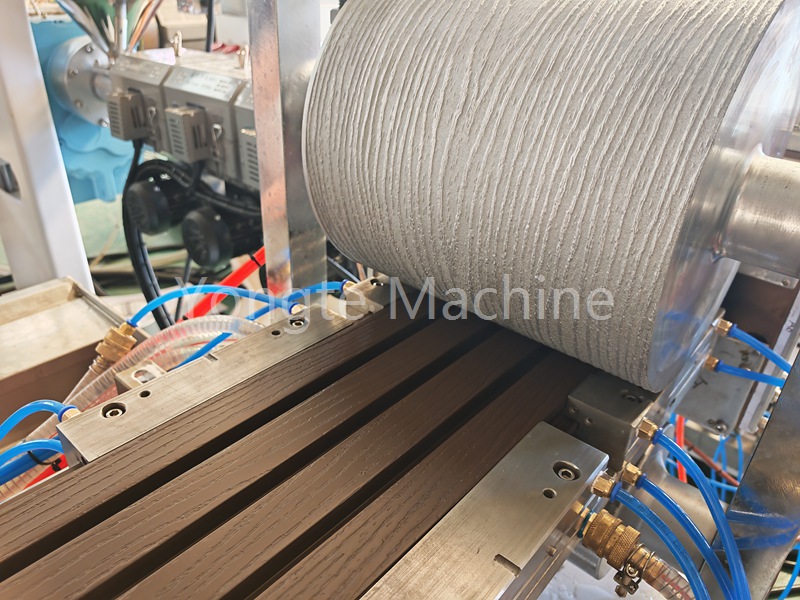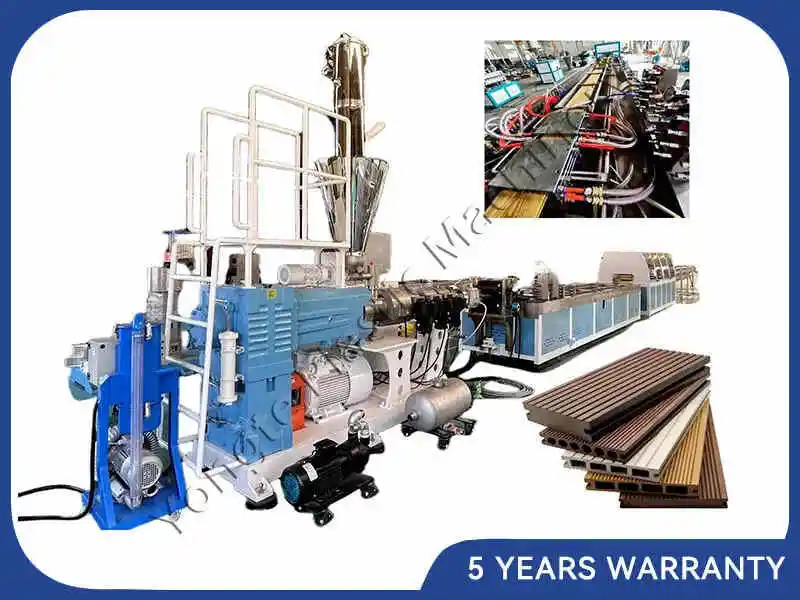Yongte Plastic Machinery's wood-plastic wallboard production line leads the new trend of green building materials
Nowadays, building decoration materials are increasingly pursuing environmental protection and durability. Wood-plastic wallboards are gradually replacing gypsum boards and wooden wallboards with their waterproof, moisture-proof, fire-retardant and flame-retardant properties, becoming the "new darling" of the decoration market. Using wood-plastic wallboards can not only save a lot of money on long-term maintenance, but also conform to the country's green and low-carbon development direction, and the market prospects are very good. Under this trend, Yongte Plastic Machinery has launched a new generation of wood-plastic wallboard production lines, which allows wood-plastic wallboards to be produced quickly and well. Compared with traditional production lines, the advantage can be called "dimensionality reduction strike".
Yongte Plastic Machinery's production line is like a "money-saving expert": when mixing ingredients, traditional production lines often rely on manual weighing, which has large errors and low efficiency, while the automatic scales used by Yongte Plastic Machinery are extremely accurate, with an error of more than 90% less than that of manual weighing, and can save 5%-8% of raw materials for each production; when installing wall panels, the modular design is also very convenient. For a 100-square-meter wall, the installation fee of wood-plastic wall panels can save 3,000-5,000 yuan compared to tiling tiles. Moreover, wood-plastic wall panels are particularly durable and can be used for 15-20 years, which is 2-3 times that of ordinary wooden wall panels. They basically do not require maintenance, and can save 40%-60% of the total cost in 10 years. In contrast, traditional production lines not only waste a lot of raw materials, but also have high maintenance costs for the wall panels produced in the later stage. In addition, Yongte Plastic Machinery's production line can also recycle heat and purify exhaust gas, reducing energy consumption by 15%, and exhaust gas emissions are only one-third of the national standard, so the company's operating costs are reduced again and again.

The strength of Yongte Plastic Machinery's production line has overturned everyone's perception of traditional production. When processing raw materials, traditional drying equipment can usually only perform simple drying, which is not only slow, but also difficult to accurately control the moisture content, resulting in problems such as bubbles and deformation in the produced wallboards. Yongte Plastic Machinery has a "double insurance" drying system. In the first step, high-temperature hot air is used to quickly reduce the moisture content of wood fiber from 12% to 5%; in the second step, it is slowly dried in a low-temperature vacuum box to keep the moisture content firmly within 3%, just like doing two precise "dehydration" of the wood fiber. This technology has also obtained a national patent, which is 60% faster than ordinary drying equipment and uses 40% less electricity, greatly improving production efficiency and reducing production costs.
When it comes to the most important extrusion molding link, many traditional extruders on the market have a single screw design, uneven raw material mixing, and unstable temperature control, which often results in yellowing and insufficient strength of wallboards. The twin-screw design of Yongte Plastic Machine is very special. The front part is thick and the back part is thin. The thick part in the front can quickly "transport" the raw materials, and the thin part in the back is equipped with an adjustable "mixer" to fully knead the wood fiber and plastic at high temperature to achieve nano-level uniformity. Moreover, the AI temperature control system on the equipment is like a 24-hour online "little housekeeper". Through 12 temperature control zones and 32 sensors, the temperature error is controlled within 1°C, which completely solves the problem of yellowing and scorching of wallboards, which is much better than the industry average. The bending strength of wallboards produced by ordinary production lines may be only about 20MPa, while the bending strength of wallboards produced by Yongte Plastic Machine can exceed 30MPa, far exceeding the national standard.

In the cooling and shaping stage, most traditional shaping equipment adopts static cooling method, and the cooling speed of wallboards is fixed, which is easy to cause uneven shrinkage, and large gaps and unevenness during installation. The "secret weapon" of Yongte Plastic Machine-three-dimensional dynamic shaping technology is completely different. The vacuum shaping table is divided into three "small rooms". The first room uses strong suction to quickly shape the wallboard, the second room adjusts the size, and the third room polishes the surface. At the same time, the spiral water cooling pipe cooperates with the intelligent water pump to flexibly adjust the cooling speed, just like giving the wallboard a "shower", so that every part of it shrinks evenly. After testing, the wallboard produced by this system has a dimensional error of only 0.3 mm, which is smaller than the industry standard of 0.5 mm. There will no longer be large gaps and unevenness during installation. The dimensional error of wallboards produced by traditional production lines is often 0.8 mm or even higher.
In the final surface treatment link, ordinary production lines can usually only operate in a single operation, with low efficiency and poor surface effect. Yongte Plastic Machinery's five-axis linkage surface treatment system is like an all-round "decoration team", which can complete the five tasks of film lamination, embossing, printing, coating wear-resistant layer and polishing edges at the same time. The printing part uses industrial-grade inkjet technology, and the printed wood grain is lifelike even with annual rings and insect eyes; the independently developed nano-coating spraying equipment can spray the wear-resistant coating thinly and evenly, with a thickness of only 0.02 mm. After 5,000 friction tests, no wear can be seen, and the wear resistance is 3 times that of ordinary wallboards. Coupled with the "double check" of AI visual inspection and laser thickness measurement equipment, the detection accuracy reaches 0.01 mm, and 99.8% of defects can be found, ensuring that each wallboard is of export-grade quality. Ordinary production lines not only have rough surface treatment, but also relatively simple inspection links, and it is difficult to ensure the consistency of product quality.

From the market trend, the development opportunities of wood-plastic wallboards are getting better and better. According to industry reports, with the increasing number of prefabricated buildings and increasingly stringent green building standards, the domestic wood-plastic material market size is expected to exceed 30 billion yuan by 2025, an annual growth of more than 18%. In Europe and the United States, wood-plastic wall panels have occupied more than 40% of the outdoor building materials market, and are now slowly expanding to interior decoration. Yongte Plastic Machinery's production line can produce 5,000 tons of wall panels per year, which is 40% more efficient than the old equipment, and the waste is reduced to less than 3%, helping companies to easily seize the market with cost-effective products. Traditional production lines not only have low production capacity, but also have a waste rate of more than 10%, which cannot meet the rapidly growing market demand.
Now, many building materials companies have gained a foothold in the market with Yongte Plastic Machinery's production lines. Whether it is domestic residential, hotel, or kindergarten projects, these high-quality wood-plastic wall panels can be seen, and the products are also exported to Europe and the United States. With leading technology, considerate after-sales service and super high cost-effectiveness, Yongte Plastic Machinery is promoting the continuous upgrading of the wood-plastic wall panel industry and injecting new impetus into the development of the green building materials industry.